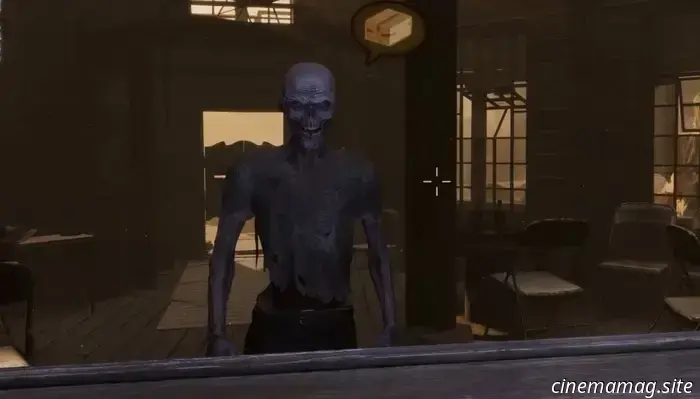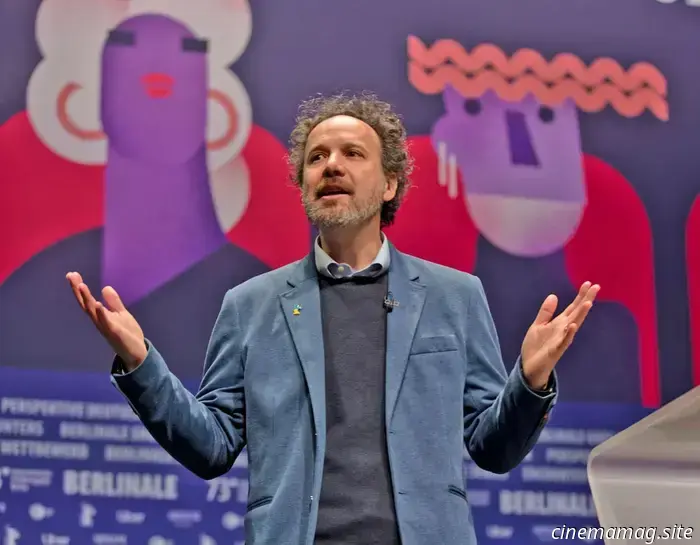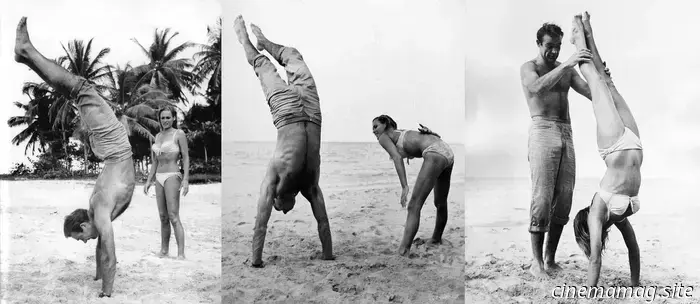.jpg)
Film Review – Train Dreams (2025)
Train Dreams, 2025.
Directed by Clint Bentley.
Starring Joel Edgerton, Felicity Jones, Kerry Condon, William H. Macy, Clifton Collins Jr., John Patrick Lowrie, Alfred Hsing, Ron Ford, Olive Steverding, Zoe Rose Short, Jennifer Simmons, Cisco Keanu Reyes, and Jerry Dykeman.
SYNOPSIS:
The narrative centers around Robert Grainier, a day laborer working as a logger involved in the expansion of railways across America. Required to be away from his wife, Gladys, and their young daughter for long stretches, Grainier struggles to find his place in a swiftly evolving world. Throughout his journey, he encounters profound love, unimaginable loss, and unique relationships, creating a story that is both individual and universal.
Almost every moment of Train Dreams is steeped in overwhelming sorrow. It doesn't resort to emotional manipulation or heaviness but instead offers a deeper, more profound resonance, exploring the nuances of its main character and the broader universe.
With Joel Edgerton delivering a remarkable performance as Robert Grainier, the early twentieth-century logger, director Clint Bentley (collaborating once again with Sing Sing's Greg Kwedar on the screenplay) adapts Denis Johnson's novella. This film narrates a comprehensive life during a pivotal developmental phase for America, capturing the highs and lows interspersed in a thoughtful manner, complemented by Bryce Dessner's evocative orchestral score. The stunning visuals by Adolpho Veloso not only delight the eye but also underline the importance of witnessing the beauty of the forests as they face destruction.
Following captivating montages and narration that detail the difficult childhood of young Robert, the film eases into his life when he meets Gladys (Felicity Jones), whom he marries, builds a home with, and starts a family. While it may appear rushed in summary, the execution reveals an immediate and moving chemistry between the actors. They understand each other and the isolated life they aspire to lead.
Robert’s work often takes him away from his family for extended periods, a pain that resonates with many in today's world, even if their absences aren't as prolonged. Logging jobs come with the risk of various fatal accidents (with multiple supporting characters providing a broader cultural perspective of America), gradually instilling in Robert a growing sense of dread about his own fate or a looming disaster.
Additionally, Train Dreams incorporates an ecological perspective; as society cuts down trees and devastates forests to build railroads and enhance connectivity, it plays God and interferes with nature. William H. Macy portrays a wise logger (and expert in demolition) who, after many years in the field, realizes the ethical implications of this destruction. His standout supporting performance shines in a film rich with poetic reflections and subtly powerful acting.
The film also explores themes that shouldn't be disclosed but can be described as haunting, steeped in survivor's guilt, inner turmoil, and a draining quest for meaning. This search often brings a heavy burden of false hope and an unbelievable twist of fate that feels genuine, despite its potential unreality. It’s a rare film that leaves viewers yearning for a happy ending, even if it feels unearned, due to the deep emotional impact of the sorrow presented. Fortunately, a touching scene near the end shows that no one is alone in their quest to comprehend the universe.
Throughout this journey, Joel Edgerton excels in conveying emotion through body language. This film provides powerful, reflective storytelling on both a personal and grand scale, depicting laborers who contribute to the foundations of the world in both impactful and detrimental ways. Train Dreams explores the search for life’s purpose, but also contemplates the beauty of the world in light of its destruction, as society continues to advance and find new, rapid ways to devastate. Yet, amidst the confusion and the mix of good and bad, beauty persists.
Flickering Myth Rating – Film: ★ ★ ★ ★ ★ / Movie: ★ ★ ★ ★
Robert Kojder is part of the Chicago Film Critics Association, Critics Choice Association, and Online Film Critics Society, and also serves as the Flickering Myth Reviews Editor. Check here for new reviews and follow my BlueSky or Letterboxd.
.jpg)
.jpg)
.jpg)
.jpg)
.jpg)
Other articles
 Ghoul's Saloon set to debut eerie pub management in 2026.
Capitalism triumphs over the undead apocalypse as Quest Craft reveals that Ghoul’s Saloon will launch on Steam in 2026. Manage the saloon and scrap stall during the day, and at night prepare defenses, set traps, and...
Ghoul's Saloon set to debut eerie pub management in 2026.
Capitalism triumphs over the undead apocalypse as Quest Craft reveals that Ghoul’s Saloon will launch on Steam in 2026. Manage the saloon and scrap stall during the day, and at night prepare defenses, set traps, and...
 One of the most poignant documentaries this year, Sepideh Farsi’s *Put Your Soul On Your Hand and Walk,* debuted at Cannes shortly after the Israeli occupation claimed the life of its subject, 25-year-old Palestinian photojournalist and poet Fatma Hassona. The film is crafted through segments of the director's FaceTime conversations with Hassona, providing a window into daily life under siege—a profound testament to enduring terror and a compelling plea for the Israeli government to halt the destruction of innocent lives.
During the film’s premiere at the New York Film Festival, I had a conversation with Farsi about how her distinctive formal approach fosters intimacy and intentional disruption, the extensive editing involved, her tribute to Fatma, Trump’s statements regarding a ceasefire, the film's reception, and more. Read on ahead of the film’s theatrical release on Wednesday, November 5.
The Film Stage: Your choice to film the conversation using your phone creates a deeply personal, emotional connection and reflects your perspective. When did this formal idea originate?
Sepideh Farsi: Yes, it was there from the very start. The original goal was to enter Gaza, which proved impossible. I then began filming other Palestinian refugees who had just left Gaza shortly before my arrival in Cairo—in late March or early April of last year. I felt frustrated because I desired to connect with someone from inside, and not being able to enter posed a challenge I was trying to address. Having done this kind of mobile filming for other projects before, it felt natural once I realized she was there and we had to connect online. I thought, “I have to document our conversation.” The mobile phone felt like the most organic option.
The intuitive choice stemmed from our conversations occurring over phones, which made it fitting to use another phone, adding dynamics and intimacy as you pointed out. Reflecting on it, it’s fitting since we’ve been witnessing this genocide through mobile devices; while we sometimes see it on TV, social media is predominantly where this conflict is conveyed. I believe the lower-quality image offers a more personal depth to the narrative.
As you mentioned, much of what we observe unfolds through mobile phones, revealing horrific stories and footage. Your film highlights another aspect of resilience, showcasing humanity as individuals strive to maintain a semblance of daily life. How crucial was it for you to depict the everyday experiences of life?
I believe my film opens a window that is usually closed, providing a human face to many Palestinian stories, especially those who have been significantly dehumanized and kept out of mainstream media narratives. Palestinians rarely have the opportunity to speak for themselves; others speak about them. This film pays tribute to someone—my aim was to listen to her. While I would encourage discussion with questions, our special relationship allowed for insights that are often unpredictable.
Despite that, the key distinction between my film and what audiences usually encounter—horrors on social media or TV—is that she resembles us. She could be your sister or my cousin, sharing the same aspirations as any other young person. She is very talented and open-minded, yet confined to her circumstances, with goals that resonate with many. This portrayal of Palestinians is rare because they aren’t allowed to be represented like this in the media.
As an Iranian exile, I have some understanding of this feeling, as I have faced similar circumstances and have found ways to express myself here over the years. Iranians have more avenues for voicing their experiences. Palestinians are significantly restricted in that capacity. This, I believe, allows audiences to connect deeply with her story—seeing someone who could be their friend only to learn of her tragic fate. Moreover, she does not express curses or hate; she exudes light, and perhaps that distinction makes an impact.
In your conversations, you address sensitive topics. As a filmmaker, did you ever hesitate to ask certain questions for fear of intruding on very personal matters? Or did you think, “This is your moment; I’ll ask everything on my mind”?
I approached it with openness. While I think I subconsciously refrained from asking particularly intimate questions about her love life or similar subjects, there were moments when she mentioned getting engaged. I chose not to include that in the film. Overall, I wouldn’t say I was self-censoring.
You mentioned having 100 hours of footage. Can you describe the editing process? Is there potential for a second film or additional footage to be released?
There could be, but it wouldn’t make sense because in editing, you focus on the strongest moments; not that the others lack value. It’s simply that due to the inherent formal consistency of the film—limited in structure to conversations, video calls, and news clips—my primary intention was to create a narrative and emotional arc. That guided my editing decisions. While each conversation was engaging, some had greater emotional resonance or unique developments. Ultimately, I had to balance the runtime; we are nearing two hours and could
A prominent figure in world cinema who has garnered the backing of Martin Scorsese, M. Night Shyamalan, Olivier Assayas, Apichatpong Weerasethakul, Béla Tarr, Claire Denis, Christian Petzold, Tilda Swinton, and Ryusuke Hamaguchi––among numerous others––Carlo Chatrian transformed the festival scene through his role as artistic director of the Locarno Film Festival and Berlinale, with his impact being so significant that a resignation from
One of the most poignant documentaries this year, Sepideh Farsi’s *Put Your Soul On Your Hand and Walk,* debuted at Cannes shortly after the Israeli occupation claimed the life of its subject, 25-year-old Palestinian photojournalist and poet Fatma Hassona. The film is crafted through segments of the director's FaceTime conversations with Hassona, providing a window into daily life under siege—a profound testament to enduring terror and a compelling plea for the Israeli government to halt the destruction of innocent lives.
During the film’s premiere at the New York Film Festival, I had a conversation with Farsi about how her distinctive formal approach fosters intimacy and intentional disruption, the extensive editing involved, her tribute to Fatma, Trump’s statements regarding a ceasefire, the film's reception, and more. Read on ahead of the film’s theatrical release on Wednesday, November 5.
The Film Stage: Your choice to film the conversation using your phone creates a deeply personal, emotional connection and reflects your perspective. When did this formal idea originate?
Sepideh Farsi: Yes, it was there from the very start. The original goal was to enter Gaza, which proved impossible. I then began filming other Palestinian refugees who had just left Gaza shortly before my arrival in Cairo—in late March or early April of last year. I felt frustrated because I desired to connect with someone from inside, and not being able to enter posed a challenge I was trying to address. Having done this kind of mobile filming for other projects before, it felt natural once I realized she was there and we had to connect online. I thought, “I have to document our conversation.” The mobile phone felt like the most organic option.
The intuitive choice stemmed from our conversations occurring over phones, which made it fitting to use another phone, adding dynamics and intimacy as you pointed out. Reflecting on it, it’s fitting since we’ve been witnessing this genocide through mobile devices; while we sometimes see it on TV, social media is predominantly where this conflict is conveyed. I believe the lower-quality image offers a more personal depth to the narrative.
As you mentioned, much of what we observe unfolds through mobile phones, revealing horrific stories and footage. Your film highlights another aspect of resilience, showcasing humanity as individuals strive to maintain a semblance of daily life. How crucial was it for you to depict the everyday experiences of life?
I believe my film opens a window that is usually closed, providing a human face to many Palestinian stories, especially those who have been significantly dehumanized and kept out of mainstream media narratives. Palestinians rarely have the opportunity to speak for themselves; others speak about them. This film pays tribute to someone—my aim was to listen to her. While I would encourage discussion with questions, our special relationship allowed for insights that are often unpredictable.
Despite that, the key distinction between my film and what audiences usually encounter—horrors on social media or TV—is that she resembles us. She could be your sister or my cousin, sharing the same aspirations as any other young person. She is very talented and open-minded, yet confined to her circumstances, with goals that resonate with many. This portrayal of Palestinians is rare because they aren’t allowed to be represented like this in the media.
As an Iranian exile, I have some understanding of this feeling, as I have faced similar circumstances and have found ways to express myself here over the years. Iranians have more avenues for voicing their experiences. Palestinians are significantly restricted in that capacity. This, I believe, allows audiences to connect deeply with her story—seeing someone who could be their friend only to learn of her tragic fate. Moreover, she does not express curses or hate; she exudes light, and perhaps that distinction makes an impact.
In your conversations, you address sensitive topics. As a filmmaker, did you ever hesitate to ask certain questions for fear of intruding on very personal matters? Or did you think, “This is your moment; I’ll ask everything on my mind”?
I approached it with openness. While I think I subconsciously refrained from asking particularly intimate questions about her love life or similar subjects, there were moments when she mentioned getting engaged. I chose not to include that in the film. Overall, I wouldn’t say I was self-censoring.
You mentioned having 100 hours of footage. Can you describe the editing process? Is there potential for a second film or additional footage to be released?
There could be, but it wouldn’t make sense because in editing, you focus on the strongest moments; not that the others lack value. It’s simply that due to the inherent formal consistency of the film—limited in structure to conversations, video calls, and news clips—my primary intention was to create a narrative and emotional arc. That guided my editing decisions. While each conversation was engaging, some had greater emotional resonance or unique developments. Ultimately, I had to balance the runtime; we are nearing two hours and could
A prominent figure in world cinema who has garnered the backing of Martin Scorsese, M. Night Shyamalan, Olivier Assayas, Apichatpong Weerasethakul, Béla Tarr, Claire Denis, Christian Petzold, Tilda Swinton, and Ryusuke Hamaguchi––among numerous others––Carlo Chatrian transformed the festival scene through his role as artistic director of the Locarno Film Festival and Berlinale, with his impact being so significant that a resignation from
 Dr. No: 13 Images from the Initial James Bond 007 Movie
Ursula Andress and Sean Connery appeared in Dr. No, the film that kicked off the James Bond 007 franchise.
Dr. No: 13 Images from the Initial James Bond 007 Movie
Ursula Andress and Sean Connery appeared in Dr. No, the film that kicked off the James Bond 007 franchise.
 Sydney Sweeney collaborates with Justin Lin for the remake of That Man From Rio.
As her new film Christy prepares to debut in theaters this week [read our review here], Deadline has announced that Sydney Sweeney has agreed to produce and star in a remake of the 1964 French adventure film…
Sydney Sweeney collaborates with Justin Lin for the remake of That Man From Rio.
As her new film Christy prepares to debut in theaters this week [read our review here], Deadline has announced that Sydney Sweeney has agreed to produce and star in a remake of the 1964 French adventure film…
 Top No Deposit Bonus Casinos | Obtain 50+ Free Spins No Deposit Casino Bonuses from the Finest Real Money Websites
The previously mentioned table displays the top 5 no-deposit bonus offers and codes for redemption in 2025. Wouldn't you like to learn more about these top no deposit options?
Continuous Sports Thrills via Live Streaming - MovieMaker Magazine
Sports revolve around significant moments; whether it's an impressive goal, an unexpected comeback, or a player hitting the crucial shot to win the game. In the current era, live streaming enables you to
Top No Deposit Bonus Casinos | Obtain 50+ Free Spins No Deposit Casino Bonuses from the Finest Real Money Websites
The previously mentioned table displays the top 5 no-deposit bonus offers and codes for redemption in 2025. Wouldn't you like to learn more about these top no deposit options?
Continuous Sports Thrills via Live Streaming - MovieMaker Magazine
Sports revolve around significant moments; whether it's an impressive goal, an unexpected comeback, or a player hitting the crucial shot to win the game. In the current era, live streaming enables you to
Film Review – Train Dreams (2025)
Train Dreams, 2025. Directed by Clint Bentley. Featuring Joel Edgerton, Felicity Jones, Kerry Condon, William H. Macy, Clifton Collins Jr., John Patrick Lowrie, Alfred Hsing, Ron Ford, Olive Steverding…
